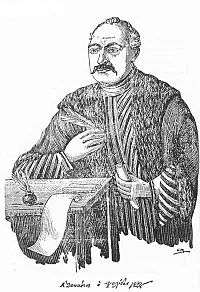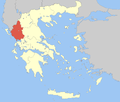Ioannina
| Ioannina Ιωάννινα | ||
|---|---|---|
|
| ||
| ||
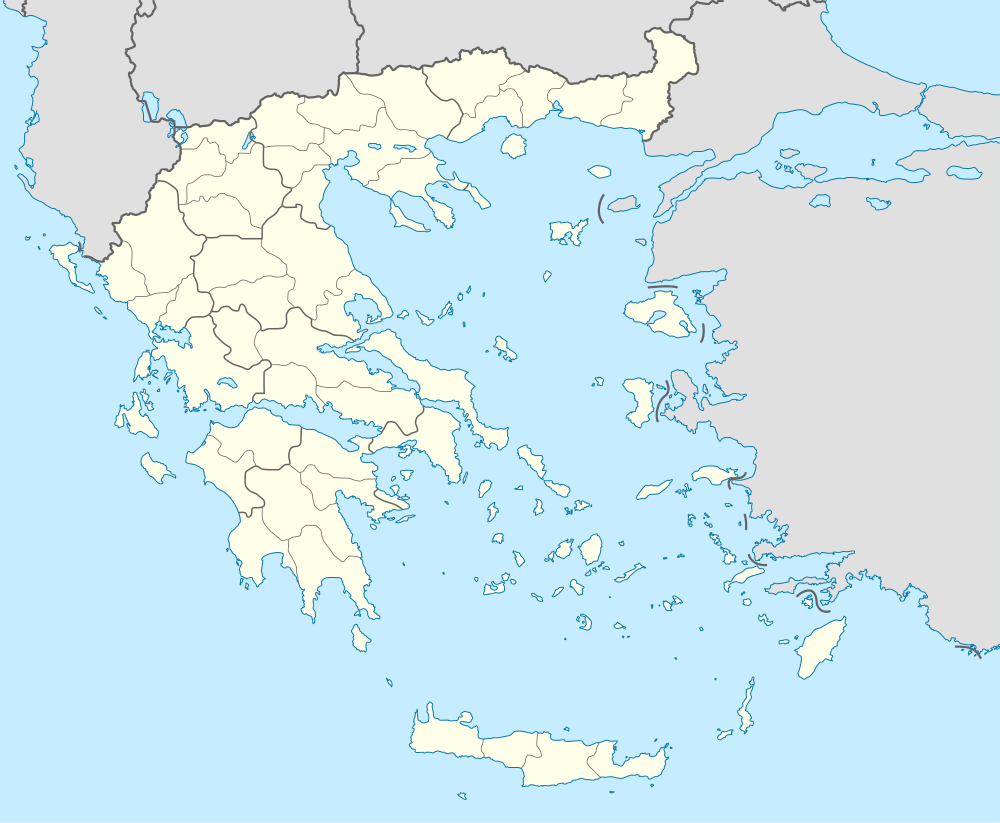 Ioannina | ||
|
Location within the region 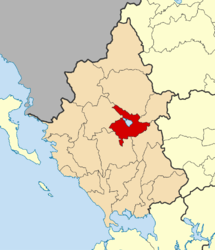 | ||
| Coordinates: 39°40′N 20°51′E / 39.667°N 20.850°ECoordinates: 39°40′N 20°51′E / 39.667°N 20.850°E | ||
| Country | Greece | |
| Administrative region | Epirus | |
| Regional unit | Ioannina | |
| Government | ||
| • Mayor | Thomas Begas | |
| Area | ||
| • Municipality | 403.32 km2 (155.72 sq mi) | |
| • Municipal unit | 47.44 km2 (18.32 sq mi) | |
| Elevation | 480 m (1,570 ft) | |
| Population (2011)[1] | ||
| • Municipality | 112,486 | |
| • Municipality density | 280/km2 (720/sq mi) | |
| • Municipal unit | 80,371 | |
| • Municipal unit density | 1,700/km2 (4,400/sq mi) | |
| Community[1] | ||
| • Population | 65,574 (2011) | |
| • Area (km2) | 17.355 | |
| Time zone | EET (UTC+2) | |
| • Summer (DST) | EEST (UTC+3) | |
| Postal code | 45x xx | |
| Area code(s) | 26510 | |
| Vehicle registration | ΙΝ | |
| Website | www.ioannina.gr | |
Ioannina (Greek: Ιωάννινα, Greek pronunciation: [io̞ˈɐ.ni.nɐ]), often called Yannena (Γιάννενα, Greek pronunciation: [ˈʝɐ.ne̞.nɐ]) within Greece, is the capital and largest city of Epirus, an administrative region in north-western Greece. Its populations is 112,486, according to 2011 census. It lies at an elevation of approximately 500 metres (1,640 feet) above sea level, on the western shore of lake Pamvotis (Παμβώτις). It is the capital of Ioannina regional unit and the region of Epirus. Ioannina is located 450 km (280 mi) northwest of Athens, 290 kilometres (180 miles) southwest of Thessaloniki and 80 km (50 miles) east of the port of Igoumenitsa in the Ionian Sea.
Founded by the Byzantine Emperor Justinian in the 6th century AD, Ioannina flourished following the Fourth Crusade, when many wealthy Byzantine families fled there in the early 13th century following the sack of Constantinople. It was part of the Despotate of Epirus from 1358 to 1416, before surrendering to the Ottomans in 1430. Between 1430 and 1868 the city was the administrative center of the Pashalik of Yanina. In the period between the 18th and 19th centuries, the city was a major center of the modern Greek Enlightenment.[2][3][4][5] Ioannina joined Greece in 1913 following the Balkan Wars.
The city has both a General and a University Hospital,[6] and is the seat of the University of Ioannina (situated 5 km (3 mi) south of the city, with 17 departments[7] and 20,000 students) as well as several departments of the Τechnological Educational Institute of Epirus,[8] the headquarters of which are located in Arta.
The city's emblem consists of the portrait of the Byzantine Emperor Justinian crowned by a stylized depiction of the nearby ancient theater of Dodona.
Name
The city's formal name, Ioannina, means "Town of John" in Greek. The establishment of a Monastery of Saint John the Baptist on the north-eastern acropolis of the castle likely marks the origin of the town's name.[9] There are two name forms in Greek, Ioannina being the formal and historical name, while the colloquial and more commonly used Jannena or Jannina (Greek: Γιάννινα) represents the vernacular tradition of Demotic Greek. The demotic form also corresponds to those in the neighbouring languages (e.g. Albanian: Janina or Janinë, Aromanian: Ianina, Enina, Turkish: Yanya).
History
Antiquity and Middle Ages

The first indications of human existence in Ioannina basin are dated back to the Paleolithic period (20,000 years ago) as testified by findings in the cavern of Kastritsa.[10] During classical antiquity the basin was inhabited by the Molossians and four of their settlements have been identified there. Despite the extensive destruction suffered in Molossia during the Roman conquest of 167 BC, settlement continued in the basin albeit no longer in an urban pattern.[11] The exact time of the town's foundation is unknown, but an unnamed new, "well-fortified" city, recorded by the historian Procopius as having been built by the Byzantine emperor Justinian I for the inhabitants of ancient Euroia, is sometimes identified with Ioannina.[12] However, it is not until 879 AD that the name Ioannina was used for the first time in the Acts of the Fourth Council of Constantinople in 879, which refer to one Zacharias, Bishop of Ioannine. The name Ioannina was also mentioned as an episcopal see, under the self-governing (autocephalous) Archbishopric of Ohrid in 1020 in an imperial document by Basil II. The city was conquered in 1082 by the Normans under the leadership of Bohemond of Taranto, who repaired the existing city walls in order to repel the offensive of emperor Alexios I Komnenos. Alexios I nonetheless recovered the city in 1108.
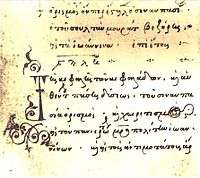
In the 13th century, the creation of the Despotate of Epirus favored Ioannina, which became its second most important city after its capital, Arta, and the capital of a thema of Ioannina.[12] The founder of the Despotate, Michael I Komnenos Doukas settled there refugee noble Byzantine families who fled Constantinople and other parts of the Empire that fell to the Latins of the Fourth Crusade. Despite frictions with local inhabitants who tried in 1232 to expel the refugees, the latter were eventually successfully settled and Ioannina gained in both population and economic and political importance.[13] The city was besieged unsuccessfully by an army from the restored Byzantine Empire, most likely in the summer or autumn of 1292.[14] Following the assassination of the last Komnenos despot by his nephew in 1318, the citizens of Ioannina broke from the despotate and declared their allegiance to the Byzantine Empire. In the same year, Ioannina became tributary to the Byzantine emperor Andronikos II Palaiologos. The city was elevated to a metropolitan bishopric, and in 1319 Andronikos II issued a chrysobull conceding wide-ranging autonomy and various privileges and exemptions on its inhabitants.[12][15]
In 1337–1340, Andronikos III Palaiologos, aided by John Kantakouzenos, dissolved the Despotate of Epirus and Ioannina became once again part of the Byzantine Empire. A few years later, however, it fell to the Serbs, who had, by then, expanded their state over much of Byzantine and Bulgarian territory to form the Serbian Empire. The city's privileges were also honored by the Serbs, and as a result Ioannina rose to economic and cultural prominence over the next century. The city flourished, becoming an important financial and cultural center. During the Byzantine times it was referred to as the "metropolis of knowledge".
The city was the capital of the restored Despotate of Epirus from 1358 to 1416. In 1366/67 the Serb Thomas II Preljubović became the new overlord of Ioannina, under whose rule the city stood against Albanian attacks. After Preljubović's death in 1384, the city surrendered to Esau de' Buondelmonti (1385–1411) and Carlo I Tocco (1411–1430).[16]
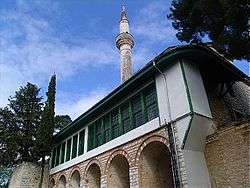
Early Ottoman period (1430–1647)
The death of Tocco in 1430 signaled the submission of Ioannina to the Ottoman Turks who granted several privileges to the town in exchange for its surrender. These were known as the Rule of Sinan Pasha, from the name of Kara Sinan Pasha, who signed the treaty. Ioannina became a seat of the Ottoman Sanjak of Ioannina.
In 1611 the city suffered a serious setback as a result of a peasant revolt led by Dionysius the Philosopher (aka Skylosophos), Bishop of Larisa. The Greek inhabitants of the city were unaware of the intent of the fighting as previous successes of Dionysios had depended on the element of surprise. Much confusion ensued as Turks and Christians ended up indiscriminately fighting friend and foe alike. The revolt ended in the abolition of all privileges granted to the Christian inhabitants, who were driven away from the castle area and had to settle around it. From then onwards, Turks and Jews were to be established in the castle area. The School of Despoton at the Church of Taxiarches, that had been operating since 1204 was closed. Aslan Pasha also destroyed the monastery of St John the Baptist within the city walls, killed the monks and in 1618 erected in its place a mosque, Aslan Camii, today a museum.[17]
Center of Greek Enlightenment (1647–1830)

Despite that blow, the city managed to recover. Its inhabitants continued their commercial and handicraft activities which allowed them to trade with important European commercial centers, such as Venice and Livorno, where merchants from Ioannina established commercial and banking houses. The first three owned printing presses that were operating in Venice and published thousands of books for the Ottoman ruled Greek people were established by members of the Ioanniote diaspora: Nikolaos Glykys (1670), Nikolaos Sarros (1687) and Dimitrios Theodosiou (1755).[18] Ioannina was the centre through which the books printed on these presses were channelled into Greece.[19] These were significant historical, theological as well as scientific works, including an algebra book funded by the Zosimades family of Ioanniotan benefactors, books for use in the schools of Ioannina such as the Arithmetica of Balanos Vasilopoulos, as well as medical books. At the same time these merchants and entrepreneurs maintained close economic and intellectual relations with their birthplace and founded charity and education establishments. These merchants were to be major national benefactors.
In the 17th century Ioannina was a thriving city with respect to population and commercial activity as both French and Turkish travelers Jacques Spon and Evliya Çelebi, respectively, attest. Evliya Çelebi visited the city in 1670 and mentioned the presence of 1,900 shops and workshops and 4,000 houses. The great economic prosperity of the city was followed by remarkable cultural activity. During the 17th and 18th centuries, many important schools were established.[20] The Epiphaniou was founded in 1647 by a Greek merchant in Venice, Epiphaneios Igoumenos.[21] The School of Gouma or Gioumeios was founded in 1676 by a benefaction from another wealthy Ioanniote Greek from Venice, Emmanuel Goumas. It was renamed Balaneios by its Rector, Balanos Vasilopoulos in 1725. Here worked several notable personalities of the Greek Enlightenment, such as Bessarion Makris, the priests Georgios Sougdouris (1685/7–1725) and Anastasios Papavasileiou (1715-?), the monk Methodios Anthrakites, his student Ioannis Vilaras and Kosmas Balanos. The Balaneios taught philosophy, theology and mathematics. It suffered financially from the capture of Venice by the French and finally stopped operation in 1820. The school's library, which hosted several manuscripts and epigrams, was also burned the same year following the capture of Ioannina by the troops the Sultan had sent against Ali Pasha.[22] Another school founded by a benefaction by merchants of the Maroutses family, who were also active Venice, the Maroutsaia School, opened in 1742 and its first director Eugenios Voulgaris championed the study of the physical sciences (physics and chemistry) as well as philosophy and Greek. The Maroutsaia also suffered after the fall of Venice and closed in 1797 to be reopened as the Kaplaneios thanks to a benefaction from an Ioanniote living in Russia, Zoes Kaplanes. Its schoolmaster, Athanasios Psalidas had been a student of Methodios Anthrakites and had also studied in Vienna and in Russia. Psalidas established an important library of thousands of volumes in several languages and laboratories for the study of experimental physics and chemistry that aroused the interest and suspicion of Ali Pasha. The Kaplaneios was burned down along with most of the rest of the city after the entry of the Sultan’s armies in 1820. These schools took over the long tradition of the Byzantine era, giving a significant boost to the Greek Enlightenment. Neophytos Doukas a famous Epirote scholar wrote, with a little exaggeration:[23]
During the 18th century, every author of the Greek world, was either from Ioannina or was a graduate of one of the city's schools.
In 1789 the city became the center of the territory ruled by Ali Pasha, an area that included the entire northwestern part of Greece, southern parts of Albania, Thessaly as well as parts of Euboea and the Peloponnese. The Ottoman-Albanian lord Ali Pasha was one of the most influential personalities of the region in the 18th and 19th centuries. Born in Tepelenë, he maintained diplomatic relations with the most important European leaders of the time and his court became a point of attraction for many of those restless minds who would become major figures of the Greek Revolution (Georgios Karaiskakis, Odysseas Androutsos, Markos Botsaris and others). Although during this time Ali Pasha committed a number of atrocities against the Greek population of Ioannina, culminating in the sewing up of local women in sacks and drowning them in the nearby lake,[24] this period of his rule coincides with the greatest economic and intellectual era of the city. As a couplet has it "The city was first in arms, money and letters". The efforts of Ali Pasha to break away from the Sublime Porte alarmed the Ottoman government, and in 1820 (the year before the Greek War of Independence began) he was declared guilty of treason and Ioannina was besieged by Turkish troops. Ali Pasha was assassinated in 1822 in the monastery of St Panteleimon on the island of the lake, where he took refuge while waiting to be pardoned by Sultan Mahmud II.
The Zosimaia was the first significant educational foundation established after the outbreak of the Greek War of Independence (1828). It was financed by a benefaction from the Zosimas brothers and began operating in 1828 and fully probably from 1833.[25] It was a School of Liberal Arts (Greek, Philosophy and Foreign Languages). The Zosimaia was badly damaged in an air raid by Italian planes in 1940 and was rebuilt on a new more spacious location with donations from Ioanniotes after 1955.[26] The mansion of Angeliki Papazoglou became the Papazogleios school for girls as an endowment following her death; it operated until 1905. Today it is a public school.
Period 1830–1943
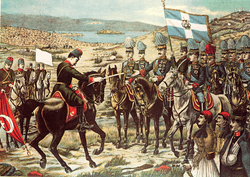
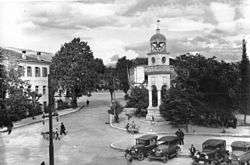
.jpg)
In 1869, a great part of Ioannina was destroyed by fire. The marketplace was soon reconstructed according to the plans of the German architect Holz, thanks to the personal interest of Ahmet Rashim Pasha, the local governor. Communities of people from Ioannina living abroad were active in financing the construction of most of the city's churches (the Cathedral, St. Nicholas of the Agora, St. Marina, Archimandrio etc.), schools and other elegant buildings of charitable establishments. The first bank of the Ottoman Empire, the Ottoman Bank, opened its first branch in Greece in Ioannina, which shows the power of the city in world trade in the 19th century. During the spring of 1877, Albanian leaders organized a congress in the city regarding decisions of the Constantinople Conference and sent a memorandum to the Ottoman government demanding, among other things, the establishment of Albanian language schools.[27][28] In May 1877 various Muslim Albanians of the Vilayet formed in Ioannina a committee which aimed at defending Albanian rights, but it was inactive in general.[29][30] On the other hand, the Greek population of the Ioannina region authorized a committee in order to present to European governments their wish for union with Greece; Dimitrios Chasiotis, a notable member of this committee, published a memorandum in Paris in 1879.[31]
Ioannina was incorporated into the Greek state on 21 February 1913 after the Battle of Bizani in the First Balkan War. After the Asia Minor Catastrophe (1922) and the subsequent population exchange, the Muslim element of the population left, and the city received Greek refugees from Asia Minor. A small Muslim community of Albanian origin continued to live in Ioannina after the exchange, which in 1940 counted 20 families and decreased to 8 individuals in 1973.[32]
Jewish community

According to the local Greek scholar Panayiotis Aravantinos, a synagogue destroyed in the 18th century bore an inscription, which dated its foundation in the late 9th century AD.[33] The existing synagogue is located in the old fortified part of the city known as "Kastro", at 16 Ioustinianou street. Its name means "the Old Synagogue". It was constructed in 1829. Its architecture is typical of the Ottoman era, a large building made of stone. The interior of the synagogue is laid out in the Romaniote way: the Bimah (where the Torah scrolls are read out during service) is on a raised dais on the western wall, the Aron haKodesh (where the Torah scrolls are kept) is on the eastern wall and at the middle there is a wide interior aisle. The names of the Ioanniote Jews who were killed in the Holocaust are engraved in stone on the walls of the synagogue.
There was a Romaniote Jewish community living in Ioannina before World War II, in addition to a very small number of Sephardi. According to Rae Dalven, 1,950 Jews were living in Ioannina in April 1941. Of these, 1,870 were deported by the Nazis to concentration camps on 25 March 1944, during the final months of German occupation.[34] Almost all of the people deported were murdered on or shortly after 11 April 1944, when the train carrying them reached Auschwitz-Birkenau. Only 181 Ioannina Jews are known to have survived the war, including 112 who survived Auschwitz and 69 who fled to join the resistance leader Napoleon Zervas and the National Republican Greek League (EDES). Approximately 164 of these survivors eventually returned to Ioannina.[35]
Today the remaining community has shrunk to about 50 mostly elderly people.[36][37] The Kehila Kedosha Yashan Synagogue remains locked, only opened for visitors on request. Emigrant Romaniotes return every summer and open the old synagogue. The last time a Bar Mitzvah (the Jewish ritual for celebrating the coming of age of a child) was held in the synagogue was in 2000, and was an exceptional event for the community.[38]
A monument dedicated to the thousands of Greek Jews who perished during the Holocaust was constructed in the city in a 13th-century Jewish cemetery. In 2003 the memorial was vandalized by unknown anti-Semites.[39] The Jewish cemetery too was repeatedly vandalized in 2009.[40] As a response to the vandalisms, citizens of the city formed an initiative for the protection of the cemetery and organized rallies.[41]
Geography
Ioannina lies at an elevation of approximately 500 metres (1,640 feet) above sea level, on the western shore of lake Pamvotis (Παμβώτις). It is located within the Ioannina municipality, and is the capital of Ioannina regional unit and the region of Epirus. Ioannina is located 450 km (280 mi) northwest of Athens, 290 kilometres (180 miles) southwest of Thessaloniki and 80 km (50 miles) east of the port of Igoumenitsa in the Ionian Sea.
The municipality Ioannina has an area of 403.322 km2, the municipal unit Ioannina has an area of 47.440 km2, and the community Ioannina (the city proper) has an area of 17.335 km2.[42]
Districts
The present municipality Ioannina was formed at the 2011 local government reform by the merger of the following 6 former municipalities, that became municipal units (constituent communities in brackets):[43]
- Ioannina (Ioannina, Exochi, Marmara, Neochoropoulo, Stavraki)
- Anatoli (Anatoli, Bafra, Neokaisareia)
- Bizani (Ampeleia, Bizani, Asvestochori, Kontsika, Kosmira, Manoliasa, Pedini)
- Ioannina Island (Greek: Nisos Ioanninon)
- Pamvotida (Katsikas, Anatoliki, Vasiliki, Dafnoula, Drosochori, Iliokali, Kastritsa, Koutselio, Krapsi, Longades, Mouzakaioi, Platania, Platanas, Charokopi)
- Perama (Perama, Amfithea, Kranoula, Krya, Kryovrysi, Ligkiades, Mazia, Perivleptos, Spothoi)
Climate
Ioannina has a borderline humid subtropical (Cfa) and Mediterranean climate (Csa) in the Köppen climate classification, since only two summer months have less than 40 millimetres (1.6 in) of rainfall, preventing it from being classified as solely humid subtropical or Mediterranean, and is tempered by its inland location and elevation. Summers are typically hot and moderately dry, while winters are wet and colder than on the coast with frequent frosts and occasional snowfall. Ioannina is the wettest city in Greece. The absolute maximum temperature ever recorded was 42.4 °C (108 °F), while the absolute minimum ever recorded was −13 °C (9 °F).[44]
| Climate data for Ioannina | |||||||||||||
|---|---|---|---|---|---|---|---|---|---|---|---|---|---|
| Month | Jan | Feb | Mar | Apr | May | Jun | Jul | Aug | Sep | Oct | Nov | Dec | Year |
| Average high °C (°F) | 10.1 (50.2) |
11.5 (52.7) |
14.4 (57.9) |
17.1 (62.8) |
23.0 (73.4) |
27.6 (81.7) |
30.8 (87.4) |
30.9 (87.6) |
26.7 (80.1) |
21.2 (70.2) |
15.5 (59.9) |
11.1 (52) |
20.0 (68) |
| Daily mean °C (°F) | 4.7 (40.5) |
6.1 (43) |
8.8 (47.8) |
12.4 (54.3) |
17.4 (63.3) |
21.9 (71.4) |
24.8 (76.6) |
24.3 (75.7) |
20.1 (68.2) |
14.9 (58.8) |
9.7 (49.5) |
5.9 (42.6) |
14.25 (57.65) |
| Average low °C (°F) | 0.2 (32.4) |
1.0 (33.8) |
3.2 (37.8) |
5.9 (42.6) |
9.6 (49.3) |
12.8 (55) |
14.9 (58.8) |
15.0 (59) |
12.2 (54) |
8.5 (47.3) |
4.7 (40.5) |
1.8 (35.2) |
7.5 (45.5) |
| Average precipitation mm (inches) | 124.2 (4.89) |
111.6 (4.394) |
95.4 (3.756) |
78.0 (3.071) |
69.3 (2.728) |
43.5 (1.713) |
32.0 (1.26) |
31.2 (1.228) |
54.0 (2.126) |
99.5 (3.917) |
167.2 (6.583) |
174.9 (6.886) |
1,181 (46.5) |
| Average precipitation days | 13.3 | 12.4 | 12.8 | 12.6 | 11.0 | 6.9 | 4.8 | 4.8 | 6.5 | 9.7 | 13.7 | 15.2 | 123.7 |
| Average relative humidity (%) | 76.9 | 73.7 | 69.5 | 67.9 | 65.9 | 59.1 | 52.4 | 54.4 | 63.6 | 70.8 | 79.8 | 81.5 | 68.0 |
| Source: Greek National Weather Service [45] | |||||||||||||
Demography
Population of the Municipality of Ioannina.
| Year | Town | Municipal unit | Municipality |
|---|---|---|---|
| 1981 | 44,829 | – | – |
| 1991 | 56,699 | 63,725 | – |
| 2001 | 61,629 | 70,203 | – |
| 2011 | 65,574 | 80,371 | 112,486 |
Population censuses, 1981–2011.
Cityscape
Landmarks and sights
Isle of Lake Pamvotis

One of the most notable attractions of Ioannina is the Ioannina Island on Lake Pamvotis. The island's official name is "Nisos Ioanninon" «Νήσος Ιωαννίνων» (Island of Ioannina). Passengers are ferried back and forth from the mainland to the island (about a 15-minute ride each way) on small motorboats which run on varying schedules, according to the season (about once every half-hour, or more, in the spring and summer, but much less frequently in the winter). Tourists can visit the monastery of Agios Panteleimon which has been converted into a museum containing information and paintings, as well as re-creations of Ali Pasha's lounging and living quarters. Ali Pasha spent the last days of his life in St Panteleimon, waiting for a pardon from the Sultan. The Island Museum is not the only attraction on the island: there are many gift-shops, tavernas, churches and bakeries on the island's winding streets. Some of the people of Ioannina even choose to make the tiny island their yearlong home, with simple rowboats moored outside their homes, or in small marinas, in the event they need to get to Ioannina proper when the motorboats are not running. The island of Ioannina in Lake Pamvotis has six monasteries: the monastery of St Nicholas (Ntiliou) or Strategopoulou from the 11th century, the Monastery of St Nicholas (Spanou) or Philanthropinon from 1292, St John the Baptist (1506 AD), Eleousis (1570 AD), St Panteleimon (17th century) and of the Transfiguration of Christ (1851 AD). The monasteries of Strategopoulou and Philanthropinon functioned also as colleges, at the latter of which taught Alexios Spanos, the monks Proklos and Comnenos and the Apsarades brothers, Theophanis and Nektarios.[17] The school continued its activities until 1758, when it was superseded by the newer collegial foundations within the city.
Ioannina Castle
Located in the center of the town, this was the heart of the Despotate of Epirus, and the Ottoman vilayet. The maze-like layout of the castle's streets (many of which lead to dead ends) was allegedly designed to confuse pirates of old who breached the castle walls: they would get lost within the fortress, and thus be captured before escaping with their booty. The south-eastern citadel bears the name Its Kale (Ιτς Καλέ, from Turkish Iç Kale, "inner fortress").[46] The Fethiye Mosque is located in Its Kale. The name means Victory Mosque; it was built in 1430 on the ruins of a Byzantine church. Its final form was given by Ali Pasha in 1795.[46] The city's Byzantine Museum is housed in a building rebuilt on the ruins of the seraglio of Ali Pasha in Its Kale, which were completely destroyed by fire in 1870. The museum opened in 1995 in order to preserve the findings of the wider region of Epirus, chronologically covering the early Christian, Byzantine and post-Byzantine period.
Greek Orthodox churches
The Cathedral of St Athanasius was completed in 1933. It was built on the foundations of the previous Orthodox Cathedral which was destroyed in the fires of 1820. It is a three-aisled basilica. It has become a place of pilgrimage for the martyrdrom of St George of Ioannina, an orphaned youth hanged in public by the Turks in 1838 for proclaiming his Christian faith. The churches of the Assumption of the Virgin at Perivleptos, Saint Nicholas of Kopanon and Saint Marina were rebuilt in the 1850s by funds from Nikolaos Zosimas and his brothers on the foundations of previous churches that perished in the great fire of 1820.
Ottoman mosques
The Fethiye Mosque is located in Its Kale. The name means Victory Mosque; it was built in 1430 on the ruins of a Byzantine church. Its final form was given by Ali Pasha in 1795.[46] From the Ottoman past of the city, another two mosques survived. One is located within the walls of the castle, the Veli Pasha Mosque. Outside the walls there is as well as the Kaloutsiani mosque, located in the are of Kaloutsiani.
Jewish Synagogue of Ioannina
The Jewish Synagogue of Ioannina is located within the walls of the Castle. During the Ottoman period, the Jewish community, both Sepharadi and Romaniote, experienced a flowering. The Jews of Ioannina were an active presence in the city's life until March 1944, when the German occupation troops arrested the entire population, 1,870 strong at the time, along with Jews from Preveza, Arta and Corfu, and deported them to the Auschwitz-Birkenau concentration camp, where most perished. Today the community consists of about 50 persons. The synagogue (7th century) lies inside the Castle of Ioannina.[46]
Other
Loulis Arcade is a commercial center in which co-existed for many years the three religious groups in the city: Christians, Jews and Muslims. Initially the gallery operated as an inn and then became a commercial center. The House Hussein Matei House (= Bishop House). The building is a ruin, but can be seen from outside.[46] Botanically, the region of Ioannina is dominated by robust, fragrant pine trees, many of which grow within the city itself, especially around the old castle, or fortress walls.
Culture
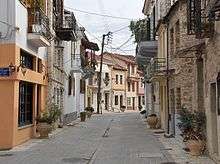
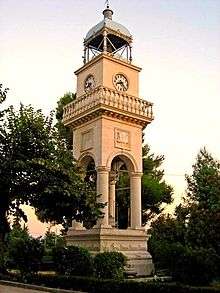
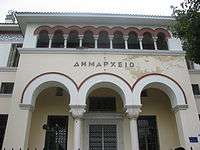
Culinary specialties
- The region of Ioannina is well known for the production of Feta cheese.
- Ioannina is also widely famous for its Baklava.[47]
Museums and Galleries
The National Archaeological Museum of Ioannina, Litharitsia Castle Square. Includes archaeological exhibits from four regional units of Epirus. You can see here the history of Epirus from prehistoric times through the 19th century.[46] Notable exhibits include palaeolithic tools, finds from Dodona, bronze vessels and votive bronzes and Frankish/Byzantine capitals taken from a church of that period.
The city's Byzantine Museum is housed in a building rebuilt on the ruins of the seraglio of Ali Pasha in Its Kale, which were completely destroyed by fire in 1870. The museum opened in 1995 in order to preserve the findings of the wider region of Epirus, chronologically covering the early Christian, Byzantine and post-Byzantine period. The museum's cultural center hosts musical and theatrical events, and issues periodic reports, among other activities. The collections include early Christian and Byzantine sculptures plus exhibits of the arts, ceramics, books, pictures and a valuable collection of silverware. During the summer season the museum operates Mondays 12.00-19.00 hours and other days 08.30-19.00. The museum is accessible to people with disabilities.
The Municipal Ethnographic Museum and its three departments, Greek, Ottoman Muslim and Jewish is hosted in Aslan Pasha Mosque, in the castle. Of particular interest are the Epirote costumes on display. The Museum of Fotis Rapakousis is located in the Aslan Mosque complex. By agreement between the city and the collector, the collection has been hosted on these premises since 2000, in cooperation with the Municipal Folklore and Ethnographic Museum, housed in the Aslan Mosque. The entire collection contains 6,000 objects, grouped in four categories: weapons with their accessories, jewelry from the 18th and 19th centuries, ceramics (Islamic art pottery of Greece, Tsanak Kale) Opening hours: 9:00 to 16:00.[46]
Near Ioannina, 10 kilometres (6.2 mi) south of the city, lies the Pavlos Vrellis Greek History Museum, a wax museum which covers events and personalities from Greek history. Established in 1995, this second Museum of Pavlos Vrellis (died 2010) is the result of the personal work of one man.[46]
The Municipal Art Gallery of Ioannina (Dimotiki Pinakothiki): Housed since 2000 in the Pyrsinela neoclassical building, built in 1890. Basil Pyrsinella who served as mayor of Ioannina, donated his movable and immovable property in 1958 to the municipality of Ioannina. In 1960 he created the first Regional Municipal Art Gallery in Greece. The gallery's collection displays major modern works of painters and sculptors, collected through purchases and donations from various collectors and artists. This includes about 500 works, paintings, drawings, prints, pictures and sculptures. Hours Monday to Friday 9:00 to 13:00 and 18:00 to 21:00. Weekends 10:00 to 13:00 and 18:00 to 21:00.[46]
Education
The University of Ioannina (Greek: Πανεπιστήμιο Ιωαννίνων, Panepistimio Ioanninon) is a university located 5 km southwest of Ioannina, Greece. The university was founded in 1964, as a charter of the Aristotle University of Thessaloniki and became an independent university in 1970.
As of 2014, there is a student population of 15,000 enrolled at the university (11,000 at the undergraduate level and 3,500 at the postgraduate level) and 580 faculty members, while teaching is further supplemented by 171 Teaching Fellows and 132 Technical Laboratory staff. The university Administrative Services are staffed with 420 employees.[48][49]
The University of Ioannina is one of the leading academic institutions in Greece.[50][51][52][53][54]
The Technological Educational Institute (T.E.I.) of Epirus was founded in 1994 in the northwestern part of Greece. It is a Public Institution, completely self-governed, and belongs to the technological sector of Greek Tertiary Education. It functions under the supervision of the Minister of Education and Religious Affairs. It has its main Campus and administrative centre in Arta and Departments in Ioannina, Preveza and Igoumenitsa. In Ioannina there is the Faculty of Health & Welfare Professions of the Institute.
Local products
- The area is also famous for its spring water Zagori, which is sold over much of Greece.
- Ioannina is famous throughout Greece for its silverwork, with a plethora of shops selling silver jewelry, bronzeware and decorative items (serving trays, recreations of shields and swords, etc.).
- Hookahs (ναργιλές) are sold to tourists as novelty items and vary in size from small (3 inches in height) to quite large (4-5 ft (2 m). tall). The larger sized hookahs are often purchased by Greeks and tourists alike to be used in home decor.
Media
- Ipirotikos Agon is a locally published newspaper.
- Proinos Logos is a locally published newspaper.
Notable Ioannites

- Christos Adamidis (1885–1949), pioneer aviator and Hellenic Army General.
- Methodios Anthrakites (1660–1736), scholar.
- Reshid Akif Pasha, Ottoman statesman
- Markos Avgeris (1884–1973), poet.
- Amalia Bakas (1897–1979), singer.[55]
- Kosmas Balanos (1731–1808), scholar.
- Mehmet Esat Bülkat (1862–1952), Ottoman general.
- İzzettin Çalışlar (1882–1951), officer of the Ottoman Army.
- Kyra Frosini (1772-1800), socialite and heroine.
- Georgios Hatzis (Pelleren) (1881–1930), author and journalists.
- Dimitrios Hatzis (1913–1981), novelist.
- Michael Christaris (1773–1851), scholar.[56]
- Josef Elijia (1901–1931), Jewish Greek poet.[57]
- Mit’hat Frashëri (1880–1949) politician and writer.
- Nikolaos Glykys (1619–1693), merchant and book publisher.[58]
- Vasileios Goudas (1779–1845), fighter of the Greek War of Independence.
- Georgios Hadjikonstas (1753–1845), benefactor.[59]
- Epifanios Igoumenos (1568–1648), scholar.[60]
- John Ioannidis (born 1965), physician and epidemiologist
- Maroutsis family, traders and benefactors.[61]
- Elisabeth Kastrisogia (1800–1863), benefactor.[62]
- Bessarion Makris (1635–1699), scholar.
- Thomas II Preljubović (1346–1416), Serbian ruler of the Despotate of Epirus
- Leonidas Palaskas (1819–1880), Hellenic navy officer.
- Grigorios Paliouritis (1778–1816), scholar.[63]
- Lambros Photiadis (1752–1805), scholar.
- Athanasios Psalidas (1767–1829), scholar, of the main contributors of the Modern Greek Enlightenment.
- Ahmed Reshadi, Kaymakam of Lezhë and Metsovo.[64]
- Abdülhalik Renda Chairman of the Turkish National Assembly.
- Dimitrios Theodosiou, book publisher.[65]
- Athanasios Tsakalov (1790–1851), one of the three founders of Filiki Eteria
- Nikolaos Sarros (1617–1697), book publisher, owner of one of the first Greek printing-houses in Venice.[66]
- Georgios Stavros (1787–1869) benefactor, founder of the National Bank of Greece.
- Simon Strategopoulos 15th-century noble and governor of Ioannina.[67]
- Georgios Sougdouris (1645/7–1725), scholar.
- Balanos Vasilopoulos (1694–1760), scholar.
- Ioannis Vilaras (1771–1823), poet and scholar.
- Hierotheos (Vlachos), theologian.
- Pavlos Vrellis (1922–2010), sculptor.
- Wehib Pasha (1877–1940), Ottoman general.
- Zosimades, benefactors, founders of the famous Zosimaia School.
Sports
Ioannina is home to a major sports team called PAS Giannina. It's an inspiration for many of old as well as new supporters of the whole region of Epirus, even outside Ioannina. Rowing is also very popular in Ioannina; the lake hosted several international events and serves as the venue for part of the annual Greek Rowing Championships.
| Sport clubs based in Ioannina | |||
|---|---|---|---|
| Club | Founded | Sports | Achievements |
| PAS Giannina | 1966 | Football | Long-time presence in A Ethniki |
| AGS Giannena | 1967 | Basketball, Volleyball | Earlier presence in A1 Ethniki volleyball |
| AE Giannena F.C. | 2004 | Football | Earlier presence in Gamma Ethniki |
| Giannena AS | 2014 | Volleyball | Presence in A2 Ethniki volleyball |
Transport
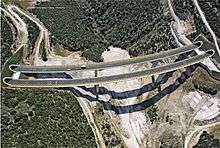
- Ioannina is served by Ioannina National Airport.
- The Egnatia Odos highway, part of the E90, passes by Ioannina. It links the west coast port of Igoumenitsa with the Turkish border.
- Air Sea Lines flew from Lake Pamvotis to Corfu with seaplanes. Air Sea Lines has suspended flights from Corfu to Ioannina since 2007.
- Long-distance buses (KTEL) travel daily to Athens (6 - 6.5 hours) and Thessaloniki (3 hours).
International relations
Twin towns – sister cities
Ioannina is twinned with:
See also
References
- 1 2 "Απογραφή Πληθυσμού - Κατοικιών 2011. ΜΟΝΙΜΟΣ Πληθυσμός" (in Greek). Hellenic Statistical Authority.
- ↑ Sakellariou M. V.. Epirus, 4000 years of Greek history and civilization. Ekdotikē Athēnōn, 1997, ISBN 978-960-213-371-2 p. 268
- ↑ Fleming Katherine Elizabeth. The Muslim Bonaparte: diplomacy and orientalism in Ali Pasha's Greece. Princeton University Press, 1999. ISBN 978-0-691-00194-4. p. 63-66
- ↑ The Era of Enlightenment (late 7th century - 1821). Eθνικό Kέντρο Bιβλίου, p. 13
- ↑ Υπουργείο Εσωτερικών, Αποκέντρωσης και Ηλεκρονικής Διακυβέρνησης Περιφέρεια Ηπείρου: "Στη δεκαετία του 1790 ο νεοελληνικός διαφωτισμός έφθασε στο κορύφωμά του. ΦορέαA_1του πνεύματος στα Ιωάννινα είναι ο Αθανάσιος ΨαλίδαA_."
- ↑ University General Hospital of Ioannina
- ↑ "University Profile - University of Ioannina". Uoi.gr. Retrieved 2013-03-26.
- ↑ Tei of Epirus. "Τεχνολογικο Εκπαιδευτικο Ιδρυμα Ηπειρου". Teiep.gr. Retrieved 2013-03-26.
- ↑ Osswald, Brendan (2008). "From Lieux de Pouvoir to Lieux de Mémoire: The Monuments of the Medieval Castle of Ioannina through the Centuries". In Hálfdanarson, Gudmundur. Discrimination and tolerance in historical perspective. Pisa: PLUS-Pisa University Press. p. 188. ISBN 978-88-8492-558-9.
- ↑ Galanidou, N.; Tzedakis, P. C.; Lawson, I. T.; Frogley, M. R. (2000). "A revised chronological and palaeoenvironmental framework for the Kastritsa rockshelter, northwest Greece". Antiquity. 74 (284): 349–355.
- ↑ Pliakou, G. (2013). "The Basin of Ioannina after the Roman Conquest. The Evidence of the Excavation Coins". In Liampi, K.; Papaevangelou-Genakos, C.; Zachos, K.; Dousougli, A.; Iakovidou, A. Numismatic History and Economy in Epirus During Antiquity (in Greek). Athens: Proceedings of the 1st International conference: Numismatic History and Economy in Epirus During Antiquity (University of Ioannina, October 3rd - 7th 2007). pp. 449–462.
- 1 2 3 Kazhdan, Alexander, ed. (1991), Oxford Dictionary of Byzantium, Oxford University Press, p. 1006, ISBN 978-0-19-504652-6
- ↑ Osswald, Brendan (2007). "The Ethnic Composition of Medieval Epirus". In Ellis, Steven; Klusáková, Lud'a. Imagining Frontiers: Contesting Identities. Pisa: Edizioni Plus – Pisa University Press. p. 132.
- ↑ Nicol, Donald (2010). The Despotate of Epiros 1267-1479: A contribution to the history of Greece in the middle ages. Cambridge: Cambridge University Press. pp. 38–42.
- ↑ Nicol, Donald (2010). The Despotate of Epiros 1267-1479: A contribution to the history of Greece in the middle ages. Cambridge: Cambridge University Press. pp. 83–89.
- ↑ Kazhdan, Alexander, ed. (1991), Oxford Dictionary of Byzantium, Oxford University Press, pp. 445, 1006, ISBN 978-0-19-504652-6
- 1 2 Γεώργιος Ι. Σουλιώτης Γιάννινα (Οδηγός Δημοτικού Μουσείου και Πόλεως 1975
- ↑ Sakellariou 1997, p. 261
- ↑ Sakellariou 1997, p. 261
- ↑ Π. Αραβαντινού, Βιογραφική Συλλογή Λογίων της Τουρκοκρατίας, Εκδόσεις Ε.Η.Μ., 1960.
- ↑ Sakellariou 1997, p. 268
- ↑ Bruce, Merry (2004). Encyclopedia of modern Greek literature. Greenwood Publishing Group. p. 11. ISBN 978-0-313-30813-0.
...were destroyed in this vast act of arson by Ali
- ↑ S. Mpettis, Enlightenment. Contribution and study of the Epirote enlightment. Epirotiki Estia, 1967, pg. 497–499.
- ↑ Nicholas Geoffrey Lemprière Hammond. Collected Studies: Alexander and his successors in Macedonia. A.M. Hakkert, 1993, p. 404.
- ↑ Κώστας Βλάχος Η., "Ζωσιμαία Σχολή Ιωαννίνων" from the archives of the Zosimaia.
- ↑ "Η Ζωσιμαία Σχολή Ιωαννίνων Ηπειρωτικόν Μέλλον, 15 Dec 1955, issue 97/328.
- ↑ Somel, Selçuk Akşin (2001). The modernization of public education in the Ottoman Empire, 1839–1908: Islamization, autocracy, and discipline. BRILL. p. 209. ISBN 978-90-04-11903-1. Retrieved 21 October 2010.
- ↑ Skendi, Stavro (1967). The Albanian national awakening, 1878–1912. Princeton University Press. p. 41. Retrieved 18 October 2010.
- ↑ Trencsényi, Balázs; Kopeček, Michal (2006). Discourses of collective identity in Central and Southeast Europe (1770–1945): texts and commentaries. Late Enlightenment – Emergence of the Modern National Idea. 1. Central European University Press. p. 348. ISBN 963-7326-52-9.
- ↑ Skoulidas, Ilias (2001). "The Relations Between the Greeks and the Albanians During the 19th Century: Political Aspirations and Visions (1875-1897)". didaktorika.gr: 92. doi:10.12681/eadd/12856.
δεν μπορούμε να μιλάμε για οργανωμένη Επιτροπή, αλλά, ενδεχομένως, για Τόσκηδες, προσηλωμένους στην αλβανική εθνική ιδέα, που είχαν παρόμοιες σκέψεις και ιδέες για το μέλλον των Αλβανών και όχι μια συγκεκριμένη πολιτική οργάνωση' δεν μπορεί να θεωρηθεί τυχαίο ότι η Επιτροπή δεν εξέδωσε κανένα έγγραφο ή σφραγίδα ή πολιτική απόφαση.
- ↑ Sakellariou M. V.. Epirus, 4000 years of Greek history and civilization. Ekdotikē Athēnōn, 1997, ISBN 978-960-213-371-2, p. 293
- ↑ Foss, Arthur (1978). Epirus. Faber. p. 56. "The population exchange between Greece and Turkey which followed removed all those of Turkish origin so that, by 1940, only some twenty Muslim families of Albanian origin were left. In 1973, only eight Muslim remained, living together in an ancient house in the centre of Ioannina. The local authorities, we are told, had refused to allow them to use one of the remaining mosques for worship, their estates remain sequestered and a long battle for what they regard as their rights has so far come to nothing. Although Albanian, they could hope for no sympathy from the present regime in Albania and there was nowhere else for them to go."
- ↑ Ellis, Steven G.; Klusáková, Lud'a (2007). Imagining frontiers, contesting identities. Edizioni Plus. p. 148. ISBN 978-88-8492-466-7. Retrieved 18 October 2010.
- ↑ An interview with the Holocaust survivor Artemis Batis from Ioannina
- ↑ Rae Dalven, The Jews of Ioannina, Cadmus Press, Philadelphia, 1990; p. 47.
- ↑ Kehila Kedosha Janina Synagogue and Museum, The Holocaust in Ioannina URL accessed 5 January 2009
- ↑ Raptis, Alekos and Tzallas, Thumios, Deportation of Jews of Ioannina, Kehila Kedosha Janina Synagogue and Museum, 28 July 2005 URL accessed 5 January 2009
- ↑ "Ioannina, Greece". Edwardvictor.com. Retrieved 2013-03-26.
- ↑
- ↑ http://www.kis.gr/en/index.php?option=com_content&view=article&id=415:desecration-of-the-jewish-cemetery-of-ioannina&catid=12:2009&Itemid=41
- ↑ http://www.jta.org/2009/12/13/news-opinion/world/ioannina-greeks-to-rally-against-cemetery-vandalism
- ↑ "Population & housing census 2001 (incl. area and average elevation)" (PDF) (in Greek). National Statistical Service of Greece.
- ↑ Kallikratis law Greece Ministry of Interior (Greek)
- ↑ Greek National Weather Service
- ↑ "EMY-Εθνική Μετεωρολογική Υπηρεσία". Hnms.gr. Retrieved 2013-03-26.
- 1 2 3 4 5 6 7 8 9 Harry Gouvas: "Ioannina Cultural Sights", Newspaper "Topiki Phoni", Preveza, 2006
- ↑ "Views of Greece". Retrieved 5 March 2012.
- ↑ Hellenic Statistical Authority (EL.STAT.), Report on Higher Education - Students, Institutes and Faculty Staff (2013/2014), press release, November 2015 (greek)
- ↑ "University of Ioannina - History". University of Ioannina. Retrieved 2016-02-03.
- ↑ Top 500 (401 to 500) - The Times Higher Education World University Rankings 2011-2016
- ↑ "CWTS Leiden Ranking 2013 - University of Ioannina". Centre for Science and Technology Studies of Leiden University. Retrieved 2016-02-03.
- ↑ UniversityRankings.ch (SERI) 2015 - University of Ioannina Retrieved in 2016-02-03.
- ↑ "Ranking Web of Universities". Webometrics.
- ↑ "Ranking university departments using the mean h-index". Scientometrics (2010) 82:211–216, Springer.
- ↑ Dorsett, Richard (22 March 2003). "Amalia Old Greek Songs in the New Land 1923–1950 (review)". Sing Out. Retrieved 21 January 2011.
- ↑ Polioudakis, Georgios (2008). Die Übersetzung deutscher Literatur ins Neugriechische vor der Griechischen Revolution von 1821 (1. Aufl. ed.). Frankfurt am Main: Lang, Peter Frankfurt. pp. 69–70. ISBN 9783631582121.
Dort wurde Christaris... und starb in 1851
- ↑ Sakellariou 1997, p. 410
- ↑ Mavrommatis], Konstantinos Sp. Staikos [kai] Triantaphyllos E. Sklavenitis ; [translation David Hardy] ; [photograph Socrates (2001). The publishing centres of the Greeks : from the Renaissance to the Neohellenic Enlightenment : catalogue of exhibition. Athens: National Book Centre of Greece. p. 12. ISBN 9789607894304.
The press owned by Nikolaos Glykys developed into the most productive centre of the Greek diaspora, and was also the longest-lived Greek press. Its founder was born in Ioannina in 1619 and moved to Venice in 1647,
- ↑ Michaēl Stamatelatos, Phōteinē Vamva-Stamatelatou. Epitomo geōgraphiko lexiko tēs Hellados. Hermes. p. 271.
Χατζηκώνστας Γεώργιος, εθνικός ευεργέτης,
- ↑ Kourmantzē-Panagiōtakou, Helenē (2007). Hē Neoellēnikē anagennēsē sta Giannena : apo ton paroiko emporo ston Ath. Psalida kai ton Iō. Vēlara, 17os-arches 19ou aiona (1. ekd. ed.). Athēna: Gutenberg. p. 26. ISBN 9789600111330.
Ένας άλλος Γιαννιώτης , ο Επιφάνειος Ηγούμενος , το 1647 κληροδοτεί ποσά για την ίδρυση δύο « νεωτεριστικών » Σχολών στα Ιωάννινα και την Αθήνα αντίστοιχα .
- ↑ Sakellariou, 1997, p. 268: "In 1742, the schools of Ioannina were increased by the foundation of a new one by the Maroutsis brothers..."
- ↑ Sakellariou, 1997, p. 305: "All these schools were called Elizabethan Schools in honour of the great benefactress Elizabeth Kastrisoia."
- ↑ Sakellariou, 1997, p. 260: Gregory Paliouritis, of Ioannina... in the church of Hagia Triada at Leghorn and teacher in the Hellenomouseion
- ↑ Özdalga, Elisabeth (2005). Late Ottoman society: the intellectual legacy. Psychology Press. p. 311. ISBN 978-0-415-34164-6. Retrieved 19 November 2010.
- ↑ al.], contributors to the exhibition, Myrto Georgopoulou-Verra, Zoe Mylona ... [et al.] ; contributors to the Cataloque, general editor Evangelia Kypraiou ... et (1999). Holy Passion, sacred images : the interaction of Byzantine and western art in icon painting. [SUNY. The University of Binghamton October 1999]. Athens: Archaeological Receipts Fund Direction of Publications. p. 104. ISBN 9789602142578.
... the third most important Greek press in Venice, owned by Demetrios and Panos Theodosiou from Ioannina. It operated from 1755 till 1824
- ↑ Sakellariou, 1997, p. 261: "Three merchants from Ioannina in Venice... Nicholas Sarros.... founded prining presses which produced hundreds of books"
- ↑ Nicol, Donald M. (1984). The despotate of Epiros, 1267–1479 : a contribution to the history of Greece in the Middle Ages ([1st ed.]. ed.). Cambridge [Cambridgeshire]: Cambridge University Press. p. 177. ISBN 9780521261906.
...the governor Strategopoulos
- ↑ "Limassol Twinned Cities". Limassol (Lemesos) Municipality. Archived from the original on 2013-04-01. Retrieved 2013-07-29.
Sources
- Sakellariou, M. V. (1997). Epirus, 4000 years of Greek history and civilization. Athens: Ekdotike Athenon. ISBN 978-960-213-371-2.
External links
| Wikimedia Commons has media related to Ioannina. |

Wikivoyage has a travel guide for Ioannina.
| Wikisource has the text of the 1911 Encyclopædia Britannica article Iannina. |
- Municipality of Ioannina (Greek)
- News and Events for the city of Ioannina
- "Here Their Stories Will Be Told..." The Valley of the Communities at Yad Vashem, Ioannina, at Yad Vashem website.




